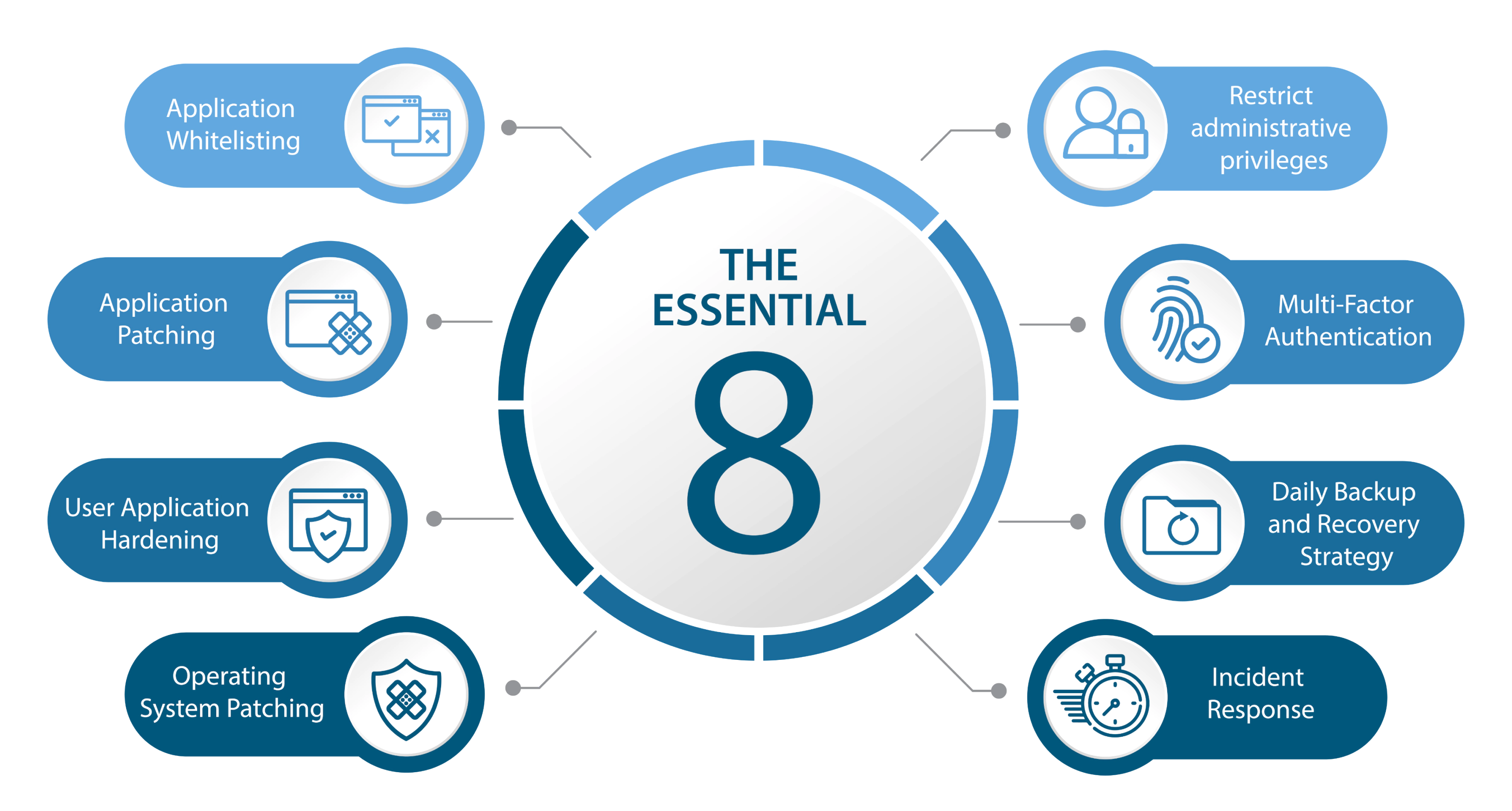
Importance Of Cyber Security Essential 8 For Businesses Part 3 - Backup And Recovery Strategy
Posted By Dipankar Chakravarty On 03 Feb 2024.
In the dynamic realm of digital business, safeguarding data has become a linchpin of organizational resilience. The Essential 8 framework, a beacon for cybersecurity, places Backup and Recovery Strategy at its core. This blog explores why this strategy is vital for mid-market and SMB customers, dissecting its nuances and embracing modern challenges.
Let’s break down this crucial aspect into simple steps of the why, when and how of data protection. At the same time presenting it in a way that all kind of audiences, technical and business alike can appreciate it. We will delve into the significance of this strategy, its nuances, and why it is paramount for every business to pay attention to it.

Imagine your business is like a castle, and the data you have is like treasure inside. The Backup and Recovery Strategy is like having guards and a map to find the treasure in case something bad happens, like a dragon attack or a flood. This strategy is key to making sure your business keeps running smoothly even if something goes wrong. Let’s explore this critical aspect with a holistic lens, tailoring it to the capabilities and resources available to any organisation.
In the fast-paced digital world, keeping your business data safe is crucial. Data Backup and recovery strategy think of it like fortifying the walls of your castle (your business) and building a shield against unexpected challenges (cyber threats). One of the most important thing is making sure at least you have a data backup and recovery strategy to start with.
Part 1: Why Backup And Recovery Is One Of Essential 8 Framework
The Essential 8 framework is designed to enhance an organisation's cybersecurity posture by focusing on key strategies. Among these, Backup and Recovery stands out as a critical component. This not only safeguards against data loss, but also ensures business continuity in the face of cyber threats and unforeseen disasters.
Imagine your business data backups as a treasure map leading to success. Unforeseen challenges, whether technological mishaps or inadvertent errors, can jeopardize your business. The backup acts as a safety net, ensuring a recent copy of your treasure map is always available, keeping your business resilient.
Just as a castle's walls provide a shield against external threats, the Essential 8 framework forms a robust defense against digital vulnerabilities. At its core lies the recovery strategy, the metaphorical castle guard, ensuring the fortress of your business data remains impervious.
Why Backup Matters
Data, the lifeblood of contemporary enterprises, necessitates a proactive approach. Understanding the value of data loss and implementing regular, automated backups is critical for business sustainability. Whether due to cyberattacks, hardware failures, or human error, the consequences of data loss can be severe. A robust backup strategy is a proactive measure to mitigate these risks.
Backing up is like creating a duplicate treasure map. It's essential to do this regularly, just like updating your map, ensuring you always have the latest version. Losing backup data is akin to misplacing your map, and a robust backup strategy ensures you're ready to recover your treasure if the unexpected happens.
Moreover, In the age of cloud proliferation and disparate data islands, a sophisticated backup approach involves intelligent, automated solutions that adapt to dynamic cloud environments. Cloud-native strategies, data consolidation, and smart backup policies are crucial elements to comprehensively protect dispersed data.
Consider your business capabilities and resources as you embark on the journey of data backup. It's not just about technical prowess, it's a commercially driven strategy. The investment in backup solutions aligns with your business's financial capabilities, ensuring a balance between cost and robust protection.
Part 2: Backup-Nuances Of-Why, When and How
Why to Backup
Understanding the value of your data and the potential impact of its loss is crucial in shaping an effective backup strategy. Backing up is creating a safeguard for your treasure map. Regularity in this process ensures the map is always up-to-date, ready for retrieval in case of unexpected events. This isn't merely a technical endeavor but a strategic business decision.
Intelligent Automation: As businesses increasingly rely on cloud applications and contend with data scattered across various platforms, intelligent and automated backup solutions become paramount.

Cloud-native Strategies : Leveraging cloud-native backup solutions ensures seamless integration with cloud environments, facilitating the protection of data residing in diverse platforms.
Data Consolidation : Implementing strategies to consolidate data islands, ensuring that all dispersed data is included in the backup scope, is crucial for comprehensive data protection.
Smart Backup Policies : Utilizing intelligent backup policies that adapt to the dynamic nature of cloud-based data, ensuring that new data is automatically included in backup routines.
Monitoring and Compliance : Employing robust monitoring tools to ensure compliance with backup policies, especially in the context of complex data landscapes.
When to Backup
Just like updating your treasure map regularly, it's essential to back up your data frequently. This ensures that the copy you have is always up-to-date, just like having the latest version of your treasure map. Whether it's daily or weekly, the key is to do it often, so you don't miss any changes.
Align the frequency of backups with business operations. It's not just about staying up-to-date but ensuring that the pace of data changes is in harmony with the rhythm of your operations. This commercial synchronization mitigates risks while keeping costs in check.
How to Backup
Employing a reliable backup solution that suits the organization's needs, considering factors like data volume, type, and accessibility. Also, with so much treasure on different islands (different cloud apps), its like having parts of your map all over the place. It would be prudent to use intelligent, smart and specialised guards (automated tools) to find these scattered map pieces and bring them together. It's like a high-tech way of making sure all your maps are safe and up to date.
Backing up involves using reliable tools or software to create duplicate copies of your data. It's like finding the right method to duplicate your treasure map and storing it in a secure place. This way, you're prepared to recover your treasure whenever the need arises.
Select backup tools and methods that are commercially viable for your business and business needs. Consider the scalability of solutions, ensuring they grow in tandem with your business. It's not just about creating duplicates; it's about adopting solutions that suit your present and future needs, economically and efficiently.
3-2-1 Strategy
This widely endorsed approach involves having three copies of your data, stored in two different formats, with one copy stored offsite, adding an extra layer of protection. It means having minimum three copies of data being stored on two different storage devices and ideally one copy is always stored off-site.
If the first copy /storage fails you can fall back on the second copy /storage within your castle. In case of a natural disaster like fire, flood, vandalism you fall back on the third copy/storage which is off site. Adding an extra layer of protection to your treasure map is like embracing the 3-2-1 strategy. This backup of your backup ensures your treasure remains safe and sound, resilient to even the most challenging scenarios.
Part 3: Recovery-Its Importance And Nuances
Why Recovery Matters
Imagine having a superhero team of guards with specialised skills and tools ready to put everything back in order after a disaster. Recovery is about more than just finding the treasure; it's ensuring you can use it right away. This is crucial for keeping your business going and making sure your customers are happy.
Having a plan for how to do this quickly is super important. While a robust backup strategy helps prevent data loss, an efficient recovery strategy ensures that downtime is minimized in the event of an incident. Quick recovery is synonymous with maintaining business continuity.
A predefined recovery plan, coupled with swift data recovery tools and technologies, ensures minimal downtime. The ability to recover quickly is not just about retrieving lost data, it's about minimizing disruptions to operations and maintaining customer trust.

Recovery is a holistic approach, not just confined to IT. It involves commercial considerations, with senior management and operations contributing to policy formation. It's not just about technical recovery, it's about ensuring that the business, as a whole, can quickly get back on track.
When
Having a predefined plan that outlines the steps to be taken immediately after a data loss incident ensures a prompt response and minimizing downtime. Predefined recovery plans, crafted with commercial foresight, outline steps for swift response after data loss. It's about minimizing downtime not just for technical reasons but to ensure business operations are disrupted minimally, aligning with overall organizational goals.
How to Recover
Utilizing swift data recovery tools and technologies is like giving your superhero team the right gadgets. Investing in these tools ensures a quick recovery, allowing your business to resume operations without missing a beat. Investing in tools and technologies that facilitate swift data recovery, including prioritizing critical systems and implementing automated recovery processes.
Implementing swift recovery tools and technologies is a commercially savvy decision. It's not just about retrieving data; it's about deploying solutions that are operationally efficient and align with the business's financial considerations. Couple of key consideration to define recovery strategies are as follows.
RPO (Recovery Point Objective)
In this holistic approach, RPO sets rules aligning data recovery with business value. A well-calibrated RPO ensures that the frequency of creating copies is not just a technical necessity but a strategic decision based on the business's tolerance for data loss.
Determining the acceptable amount of data loss in the event of an incident is essential. RPO helps in setting a time limit, indicating how frequently backups should be taken to meet business requirements. Think of RPO as setting rules for how often you want to make copies of your treasure map. If your RPO is one day, it means you're comfortable with losing the data changes made in the last 24 hours. It's about ensuring your treasure map copies are recent enough to be valuable.
RTO (Recovery Time Objective)
This defines the maximum allowable downtime for systems and services. Understanding RTO helps in selecting appropriate backup and recovery solutions to meet the organization's operational needs. Consider how quickly you want to find your treasure if something happens. RTO sets the maximum time you're willing to wait. If your RTO is one hour, it means you want to find your treasure within an hour of a problem occurring. This ensures a swift recovery, keeping your business on track.
RTO, in a commercial context, becomes a crucial metric. It's not just about swift recovery; it's about defining the acceptable downtime that aligns with minimising operational loss in dollar terms. This economically informed objective ensures that recovery efforts are synchronized with business continuity goals. Too high expectation would be cost prohibitive, too low objective might lead to substantial financial losses where the whole effort becomes futile.
Part 4: Other Consideration
Objective of larger Essential 8 framework
Just as the objective of digging a moat around a castle is to create an added layer of protection, the objective of Essential 8 framework is to fortify your business against data loss. It's not merely a technical necessity but a strategic initiative to maintain business continuity and resilience. So adopting the compete framework would protect your business treasure more effectively that just having a backup and recovery strategy.
Commensurate Budget
Securing a castle requires a budget commensurate with the value it protects. Similarly, allocating resources for backup and recovery should align with the criticality of your business data. A well-funded strategy ensures that your castle remains impregnable against data breaches and disruptions.
Technical Skill Set
Managing the complexities of a castle requires skilled artisans and architects. Similarly, the technical skill set required for the intricacies of backup and recovery ensures that your data defence mechanisms are not just robust but also intelligently deployed. It's about having the right people with the right skills to safeguard your digital fortress.
Part 5: Using Managed Backup Services
Now, imagine if you could hire expert guards to watch over your treasure and make sure all your maps are safe. That's what Managed Backup Services do for your data. They keep an eye on things 24/7, check everything regularly, and jump into action if something seems off. This way, you can focus on running your business while knowing your treasure is safe and sound.
For mid-market and SMB customers, managing an in-house backup and recovery system can be resource-intensive. This is where Managed Backup Services come into play. These services offer a proactive approach to data protection, often providing 24/7 monitoring, regular testing, and quick response in case of an incident. By outsourcing this critical aspect of cybersecurity, organizations can focus on their core business activities while ensuring their data remains secure and recoverable.

Now, envision hiring expert guards who understand the value of your treasure and ensure its safety. Managed Backup Services become commercially driven guardians. They keep a vigilant eye on your data, checking regularly, and are ready to act swiftly. This commercial outsourcing allows businesses to focus on operations while having the peace of mind that their treasure is secure.
Conclusion
In the digital dance of ones and zeros, the Essential 8 framework stands as a guiding beacon for businesses aiming to keep their data safe. The Backup and Recovery Strategy, nestled within this framework, is like having a map and guards for your treasure. For mid-sized and small businesses, these simple steps ensure that your most valuable asset—your data—is protected, no matter what twists and turns the digital world throws your way. With Recovery Point Objectives, Recovery Time Objectives, and the 3-2-1 strategy in place, your treasure is not only secure but ready to shine even after the storm. At the same time if you want peace of mind use specialised teams like expert guards, Managed Backup Services are there to stand watch, ensuring your business thrives in the ever-evolving digital landscape.

In conclusion, just as a castle stands strong with its walls, moat and vigilant guards. The Essential 8 framework complemented with a strategic backup and recovery strategy fortifies your business againts the ever present digital challenges. Implementing the 3-2-1 strategy, understanding the nuances of backup and recovery, and employing managed backup services ensure that your digital fortress remains impervious, preserving the treasure of your business data.
Read more for backup services Katalyst Consulting Services has to offer
Read more for complete backup solution Katalyst Consulting has to offer